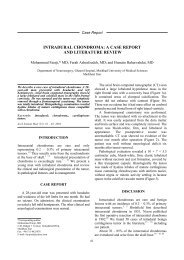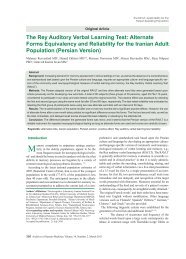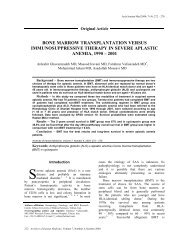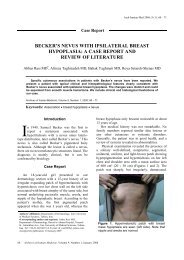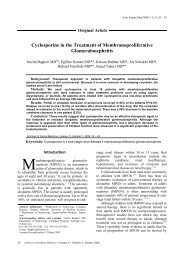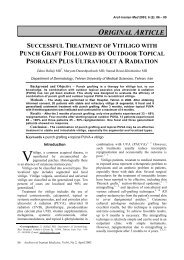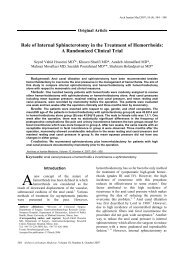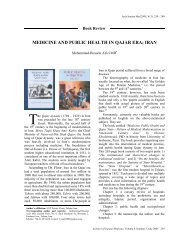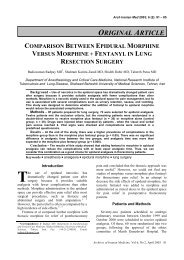NEONATAL TRANSPORT IN TEHRAN: A CAUSE FOR MUCH ...
NEONATAL TRANSPORT IN TEHRAN: A CAUSE FOR MUCH ...
NEONATAL TRANSPORT IN TEHRAN: A CAUSE FOR MUCH ...
Create successful ePaper yourself
Turn your PDF publications into a flip-book with our unique Google optimized e-Paper software.
M. Kazemian, S. H. Fakhraee, F. Zonouzi• well-functioning equipment (e.g. transportincubator, ventilator...);• trained personnel skilled in neonatalresuscitation and stabilization;• well-functioning and well-equipped vehicles;• good roads and highways; and• good communication between primary andreferral hospital.In Tehran there are few NICUs where thetrained personnel and necessary equipment areavailable for the care of high-risk neonates.Because of shortage of these facilities, many ofthe sick neonates who need to be transported cannot obtain admission. Even when they can obtainadmission, their transport is delayed and veryinefficient due to lack of good communication,transport vehicle, and trained personnel, etc. Inthis study, we attempt to clarify some of theinadequacies in regard to neonatal transport inTehran and to give some suggestions topolicymakers in order to improve neonataltransport and reduce neonatal morbidity andmortality.Patients and MethodsIn this study, 16 maternity hospitals withoutNICU facilities in different geographical locationsof Tehran were selected randomly forparticipation during the month of November 2002.All infants born at these hospitals during thatperiod who were candidates for transport toNICUs according to the universal standards wereincluded in this study. 6 By reviewing severaltransport protocols we prepared a questionnaireand distributed it to the head nurses of theneonatal units of the participating hospitals. Thepediatricians of these hospitals determined theeligibility of the neonates for transport accordingto the above-mentioned criteria.All of the information regarding the transportof these babies were extracted from thequestionnaires and analyzed using SPSS software.ResultsIn the participating hospitals, 3,125 infantswere born during the study period. Of these, 320(10.24%) needed admission to a special care unitdue to complications such as respiratory distressand surgical problems. Of the 320 patients whorequired transport and admission, only 22 infants(6.87%) from 13 centers were able to obtainadmission.Fifteen (68.18%) of the infants who receivedtransport were premature while seven (31.82%)were born full-term. The mean ± SD age of theinfants at the time of request for transport was 3.8± 3.07 hours and the mean ± SD birth weight was1.92 ± 0.28 kg. The reason for transport in 17cases (77.27%) was respiratory distress and in fiveothers (22.73%) transport was desired for surgicalproblems. Three of the fifteen premature infants(13.63% of all the infants requiring transport) diedbefore they could obtain admission.The mean ± SD waiting time for admissionwas 110 ± 50 min and the mean ± SD elapsedinterval between receiving confirmation ofadmission acceptance, and exiting the primaryhospital was 50 ± 26 min. The mean ± SD intervalbetween leaving the referring hospital and arrivingat referral hospital was 46 ± 17 min. In 16 cases(84.21%) the father accompanied the infant, whilein 3 cases (15.79%) another relative accompaniedthe infant. Health care professionals also oftenaccompanied the patient; in 15 cases (78.9%) anurse and in 4 cases (21.1%) interns accompaniedthe patient.Out of these 19 health care personnel whoaccompanied the patients, only 8 (42.1%) hadparticipated in neonatal resuscitation workshops.None of the transported infants was intubated butall of them had intravenous lines.In 11 cases (57.9%) the transport vehicle was ahospital ambulance while in rest of the cases, itwas a private ambulance. None of the ambulanceshad optimal equipment such as proper-sized bagand mask, transport incubators, monitors,equipment for temperature regulation, or transportventilators. In seven cases, (36.84%) a transportincubator was used and in 12 cases (63.16%)blankets were used to warm the baby duringtransport. Cardiopulmonary resuscitation (CPR)was performed on one premature infant duringtransport. It was unsuccessful and the patient diedbefore reaching the referral hospital. Three otherpremature infants had mechanical ventilationintermittently with bag and mask during transportbut none was intubated. None of the health careprofessionals who accompanied the babies hadexperience with neonatal tracheal intubation.DiscussionIn most developed countries, critically illArchives of Iranian Medicine, Volume 7, Number 4, October 2004 257



